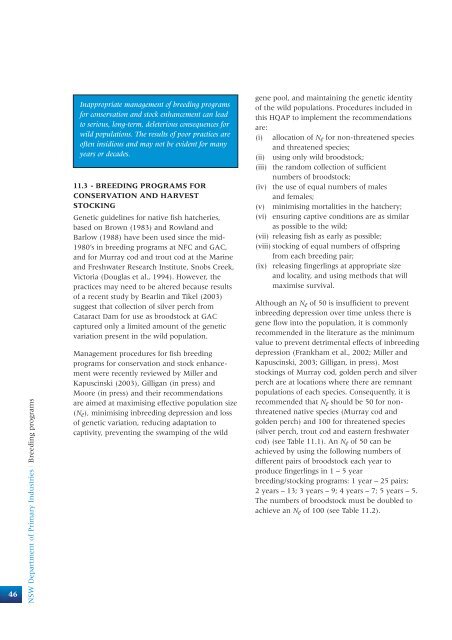Hatchery Quality Assurance Program - NSW Department of Primary ...
Hatchery Quality Assurance Program - NSW Department of Primary ...
Hatchery Quality Assurance Program - NSW Department of Primary ...
Create successful ePaper yourself
Turn your PDF publications into a flip-book with our unique Google optimized e-Paper software.
46<br />
<strong>NSW</strong> <strong>Department</strong> <strong>of</strong> <strong>Primary</strong> Industries | Breeding programs<br />
Inappropriate management <strong>of</strong> breeding programs<br />
for conservation and stock enhancement can lead<br />
to serious, long-term, deleterious consequences for<br />
wild populations. The results <strong>of</strong> poor practices are<br />
<strong>of</strong>ten insidious and may not be evident for many<br />
years or decades.<br />
11.3 - BREEDING PROGRAMS FOR<br />
CONSERVATION AND HARVEST<br />
STOCKING<br />
Genetic guidelines for native fish hatcheries,<br />
based on Brown (1983) and Rowland and<br />
Barlow (1988) have been used since the mid-<br />
1980’s in breeding programs at NFC and GAC,<br />
and for Murray cod and trout cod at the Marine<br />
and Freshwater Research Institute, Snobs Creek,<br />
Victoria (Douglas et al., 1994). However, the<br />
practices may need to be altered because results<br />
<strong>of</strong> a recent study by Bearlin and Tikel (2003)<br />
suggest that collection <strong>of</strong> silver perch from<br />
Cataract Dam for use as broodstock at GAC<br />
captured only a limited amount <strong>of</strong> the genetic<br />
variation present in the wild population.<br />
Management procedures for fish breeding<br />
programs for conservation and stock enhancement<br />
were recently reviewed by Miller and<br />
Kapuscinski (2003), Gilligan (in press) and<br />
Moore (in press) and their recommendations<br />
are aimed at maximising effective population size<br />
(Ne), minimising inbreeding depression and loss<br />
<strong>of</strong> genetic variation, reducing adaptation to<br />
captivity, preventing the swamping <strong>of</strong> the wild<br />
gene pool, and maintaining the genetic identity<br />
<strong>of</strong> the wild populations. Procedures included in<br />
this HQAP to implement the recommendations<br />
are:<br />
(i) allocation <strong>of</strong> Ne for non-threatened species<br />
and threatened species;<br />
(ii) using only wild broodstock;<br />
(iii) the random collection <strong>of</strong> sufficient<br />
numbers <strong>of</strong> broodstock;<br />
(iv) the use <strong>of</strong> equal numbers <strong>of</strong> males<br />
and females;<br />
(v) minimising mortalities in the hatchery;<br />
(vi) ensuring captive conditions are as similar<br />
as possible to the wild;<br />
(vii) releasing fish as early as possible;<br />
(viii) stocking <strong>of</strong> equal numbers <strong>of</strong> <strong>of</strong>fspring<br />
from each breeding pair;<br />
(ix) releasing fingerlings at appropriate size<br />
and locality, and using methods that will<br />
maximise survival.<br />
Although an Ne <strong>of</strong> 50 is insufficient to prevent<br />
inbreeding depression over time unless there is<br />
gene flow into the population, it is commonly<br />
recommended in the literature as the minimum<br />
value to prevent detrimental effects <strong>of</strong> inbreeding<br />
depression (Frankham et al., 2002; Miller and<br />
Kapuscinski, 2003; Gilligan, in press). Most<br />
stockings <strong>of</strong> Murray cod, golden perch and silver<br />
perch are at locations where there are remnant<br />
populations <strong>of</strong> each species. Consequently, it is<br />
recommended that Ne should be 50 for nonthreatened<br />
native species (Murray cod and<br />
golden perch) and 100 for threatened species<br />
(silver perch, trout cod and eastern freshwater<br />
cod) (see Table 11.1). An Ne <strong>of</strong> 50 can be<br />
achieved by using the following numbers <strong>of</strong><br />
different pairs <strong>of</strong> broodstock each year to<br />
produce fingerlings in 1 – 5 year<br />
breeding/stocking programs: 1 year – 25 pairs;<br />
2 years – 13; 3 years – 9; 4 years – 7; 5 years – 5.<br />
The numbers <strong>of</strong> broodstock must be doubled to<br />
achieve an Ne <strong>of</strong> 100 (see Table 11.2).

















